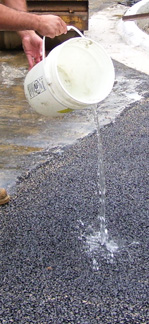
By definition, a pavement is the durable, hard surfaced material laid down on an area to carry vehicular or pedestrian traffic, such as a highway or walkway. Traditional pavements are designed as waterproof barriers to prevent the softening of underlying support layers (base or subgrade) caused by water intrusion.
Since most pavements are designed to shed water, a collection system is needed for channelizing and carrying away excess rain and ground water from paved streets, parking lots, sidewalks, and roofs. Storm drainage systems vary in design and complexity from small roadside ditches, to the very large underground piping networks found in municipal storm systems.
In the last two decades, a new class of pavement known as porous pavement has been placed in the toolbox of engineers and architects. Some of the potential application opportunities for porous pavements are parking lots, urban areas, locations with limited space for drainage structures, a facility seeking LEED® certification and anywhere conditions warrant its consideration.
When used as part of an integrated storm water management plan, porous pavements allow storm water to infiltrate through the pavement into a single-sized stone reservoir where it will then infiltrate into the subsoil. By moving through these structures the water is filtered and cleaned before recharging the underground aquifer.
Benefits to storm water quality
Research in Europe and in the U.S. consistently confirms the environmental advantages of porous pavement. According to a University of New Hampshire study, porous pavements are highly effective at removing suspended solids, phosphorous, zinc and petroleum hydrocarbons.
Other researchers have documented similar results over the last 20 years. With the slow release from the recharge bed, aquifers are provided with a renewal source. Moreover, with the use of the parking area as its own drainage facility, traditional drainage via curb and gutter, drop inlets, etc. is not required.
Engineering challenge
The city of Ann Arbor, Michigan, was recently faced with the challenge of rehabilitating a street located in an older residential area of the city, near the University of Michigan campus. Sylvan Avenue is a relatively flat 800-foot long street originally built without subsurface drainage.
Drainage control was a shallow “v-gutter” lining the entire length of the project that emptied into inlets near White Street on the west or lower end. Because the entire area is relatively flat, ponding of surface water was a chronic problem that accelerated the deterioration of the pavement structure.
Hazardous icing conditions
The geology of the surrounding area also complicated the drainage issue. Soil borings indicated a layer of clay 10 feet below ground that prevented water from entering the aquifer.
During wet weather, groundwater would backup into the basements of the homes along the street. Without drainage structures, homeowners drained their basement sump pumps directly into front yards, where the water would flow across the sidewalks into the gutters lining the street. During winter months, hazardous icing conditions from ponded water existed both in the street and along the sidewalks.
Design considerations
According to Nicholas Hutchinson, Project Engineer, for the City of Ann Arbor on the Sylvan Avenue project, the city and their design consultant, Fishbeck, Thompson, Carr & Huber Inc. of Grand Rapids Michigan, soon realized drainage would be the main design consideration in determining the pavement cross-section.
The tie-in elevation on the existing White Street storm sewer was relatively high, which would require a shallow pipe installed very high up in the pavement. The decision was made to use a porous pavement and reconfigure the reservoir, not to recharge the aquifer, but to act as an engineered conduit to carry the groundwater the length of the project and drain into an existing manhole at the low end of the project.
Construction phase
Clean sand filter
After the existing pavement was removed to a uniform depth, the subgrade was excavated to a smooth, flat bottom, cross-section at a minimum longitudinal slope. An impervious liner of PVC fabric was placed on the subgrade covering the distance from back of sidewalk to back of sidewalk. The liner acts as a trough to carry water the length of the project and away from the basements.
Next, a six-inch underdrain pipe was laid the length of the project centerline to drain the water away and prevent it from accumulating on the impervious blanket. Then, a six-inch layer of clean filter sand was placed over the entire width of the subgrade to provide final cleaning and filtering of pollutants from the water.
Aggregate reservoir
Prior to placing the stone reservoir, a woven geotextile fabric was installed on the surface of the filter sand to act as a filter and a barrier to prevent the clean sand from migrating into the stone base over time. The single-sized aggregate that forms the reservoir has 35- 40 percent voids and was placed 18-24 inches thick directly on the geotextile fabric. The reservoir’s capacity is designed to handle a 100-year rain event. The MDOT 6A aggregate (maximum size ¾ inch) was placed in two equal lifts, by pushing onto the fabric to prevent over-compaction (reduced voids) and damage to the fabric by delivery trucks and placing equipment.
Pavement section
A standard PCC curb and gutter with depressed curb sections at driveways was built to capture runoff from the adjacent properties and carry the water to inlets at the low end of the project. The porous hot-mix asphalt pavement was a 50-gyration mix design, with 5-6.5 percent asphalt content, laid 3 inches thick. The mat was compacted using 3-5 passes of a static steel wheel roller to smooth the mat without crushing or displacing aggregate. In-place density ranged from 75-85 percent or 15-25 percent porosity.
Improved drainage and safety considerations
To cut down on water ponding on sidewalks and icing over in the winter, continuous underdrains were placed below the sidewalks to capture surface water and divert it directly into the manholes at the end of the project. As a part of this system, a direct tap was installed at each property to allow homeowners a connection into the drainage system for their sump pump outlets.
Maintaining porous pavements
Just as the design and construction of porous pavements are unique, so are the maintenance requirements for these surfaces. For obvious reasons porous pavements should never receive a seal coat.
Failures of porous pavements generally come from clogging due to inadequate maintenance. To alleviate the possibility of clogging, cleaning operations may be needed. Vacuuming the surface twice a year then pressure washing clogged areas will generally suffice.
Snow removal on porous pavements has unique requirements as well. Sanding operations must be avoided to prevent clogging the pavement. Lighter use of deicing salts than is typical for the area is also advisable for two reasons. First, porous pavements tend to de-ice faster so they do not need as much salt to aid with deicing. Second, aggressive salting can affect the salinity of local aquifers via the recharge mechanism.
Conclusion
The Sylvan Avenue project completed its second winter and Hutchinson says the porous pavement continues to perform exactly as the city anticipated.
Based on the success of the Sylvan Avenue project, the City of Ann Arbor has added porous pavement to their storm water management toolbox. Recently the city opened bids on a second porous asphalt pavement that is scheduled to be completed during the 2012 construction season.
Wayne Jones is an Asphalt Institute Senior Regional Engineer based in Ohio.













